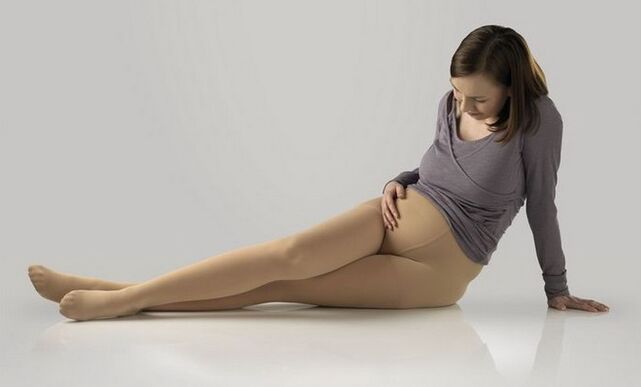Vein pathology is most commonly seen in diseases of the lower extremities, but in some cases such manifestations as varicose veins of the labia in women may occur even in the absence of leg problems. This condition can be caused by a number of factors that negatively affect the veins in this area, disruption of blood flow in the pelvic organs and peculiarities of lifestyle and work. Most often such pathology of the female genital organs is observed in early pregnancy, when the load on this area increases many times, but symptoms of this disease can occur and with a number of provoking factors that must be taken into account to maintainon the health of the female reproductive system.
What is the disease?
Varicose veins of the labia in the presence of symptoms characteristic of this pathology can be observed due to hereditary predisposition, but the beginning of pregnancy has the greatest impact on the development of the disease and its further progression. It is during this period that hormonal changes occur in the body, body weight gradually increases, which leads to increased pressure on the genitals of a woman with bulging veins, which characterizes the development of varicose veins.
The detection of this disease is performed by a phlebologist, who through an external examination can even determine the initial stage of the disease. For a more accurate diagnosis, a number of examinations of the woman's labia are performed, which will allow not only to identify the presence of bulging veins, but also to establish the stage of the pathology. Accurate diagnosis, during which varicose veins of the vulva are detected, allows the doctor to prepare the most effective treatment regimen that will allow to quickly eliminate the obvious manifestations of the pathology.

The initial stage of development of varicose veins in this part of the woman's body has relatively minor manifestations (eg heaviness and feeling of fullness in the perineum, itching and burning, which are most pronounced during urination), as the progression of symptomsincreases, which significantly reduces a woman's overall quality of life and worsens the discomfort that can occur as the pregnancy progresses. For this reason, the earlier the necessary treatment is started, the easier the pregnancy will be tolerated by the woman and the less likely it is that the side effects of this pathology will occur in the future.
Symptoms of varicose veins of the labia
The manifestations of the considered disease of the female genital organs are quite characteristic, which allows to identify it in the early stages of development and to prevent the worsening of the manifestations. Varicose veins of the labia occur as a result of changes in hormone levels and during the beginning and development of pregnancy, when there is a significant increase in body weight affecting a woman's genitals and lower extremities.
The following manifestations should also be attributed to the symptoms of the disease in question:
- the appearance of a feeling of fullness in the perineal area;
- burning and itching, which are especially pronounced when urinating;
- increase in the size of the labia, due to the protrusion of the veins from the surface of the organ;
- swelling of the tissues;
- discomfort during intimate relationships;
- soreness even during hygienic procedures;
- increase in the size of the veins in the perineal area, which can be detected even when probing this area.
In addition to the listed symptoms, which allow to detect the current pathology at an early stage of its development, subjective manifestations can be noted, which appear with the onset of pregnancy and with hormonal disorders.
Causes of varicose veins of the labia
The causes of circulatory disorders in the perineum and labia are most often the development of pregnancy, as well as hormonal changes in the body that occur during this period.

However, there are a number of factors that negatively affect the female genital area and predispose to the development of this pathology. Phlebologists refer to such provoking factors:
- Heredity. If someone in the family has had venous disease, circulatory disorders or venous insufficiency, then a woman can expect varicose veins in the perineum, especially the labia, during pregnancy.
- Sedentary lifestyle and lack of physical activity. Stagnation in blood flow, especially in the pelvic organs, can lead, with a lasting negative impact, to the development of this disease.
- Overweight. This is a significant body weight, which is primarily able to provoke a negative effect on the veins of the lower extremities and pelvis, therefore, controlling your own weight, timely removal of extra pounds will help prevent the development of varicose veins in any part ofthe body.
The tendency of the veins of the labia to reduce their tone, bulge and circulatory disorders process may also become an indirect causal development of the pathology in question. The combination of causes and provoking factors should be considered as the main reason for the onset and further exacerbation of venous insufficiency in the perineum of the labia. Varicose veins of the labia tend to occur in the presence of direct causes of its development (the appearance and development of pregnancy, hormonal changes in the body during this period), as well as in the presence of provoking factors and untimely detection of the initial stage of pathology.
Varicose veins of the genitals, which occurs during pregnancy, can be considered a relatively common disease, which in the first half of pregnancy occurs in about 40-60% of pregnant women, during the development of pregnancy can betraced in 10-20% of women. A phlebologist and gynecologist leading the pregnancy will help to make an accurate diagnosis over time, prepare a treatment plan and further preventive effects.
Methods of treatment
Treatment of varicose veins of the labia is carried out only after the final and confirmed diagnosis is made, while the woman's condition and during pregnancy should be taken into account. It is necessary in the course of the therapeutic effect to make the necessary adjustments to identify possible side effects of drugs used in the body of a pregnant woman, so as not to provoke the development of side effects in the form of allergies, exacerbation of existing symptoms.
The most effective methods of treating varicose veins of the perineum and labia are considered to be a combination of changes in a woman's lifestyle, increase physical activity, and perform certain physiotherapy procedures to improve blood circulation inthe organs of the small pelvis. The use of drugs is pre-agreed with the attending physician, a test is performed for the occurrence of allergic reactions on the body of the pregnant woman and an exposure scheme is prepared, which will eliminate any adverse effects of such treatment. Surgery can be performed, which is usually prescribed at an advanced stage of the disease.

Ointments for external use
Venotonic ointments provide the fastest penetration of the active substance directly into the affected area, and the symptoms are eliminated after the first few applications of the ointment. First of all, when you use them, painful sensations and itching are eliminated.
Among the effective drugs for the treatment of varicose veins of the labia are considered to be healing ointments, which are applied to the affected area regularly 2-3 times a day for a period of time determined by the attending physician. The duration of their use depends on both the stage of the disease and the degree of sensitivity of the body to the active substance of the selected drug.
Surgery
Surgery can be prescribed at an advanced stage of the disease, when the symptoms do not allow normal sexual life, delivers unpleasant and painful sensations in everyday life. Surgery allows you to remove the bulging veins, to stabilize the blood circulation in the labia.
However, this method of therapeutic action can be used only if there is evidence and with the appointment of a physician.
Compression underwear
The use of compression garments, which will ensure the normal position of the veins and provide the necessary movement in the tissues of the labia, is an excellent alternative to other methods of therapeutic action. There are several brands of such underwear, usually prescribed in the early stages of the disease.
Home treatment with folk methods
The treatment of this pathology is possible at home with the help of folk methods, but this type of exposure must be agreed in advance with the attending physician. The most effective in the initial stage of pathology and as a prophylactic.
Varicose veins, which are characteristic of the labia, can be treated with cold compresses, mountain ash juice, sitting baths.
Cold compresses, as practice shows, allow you to eliminate itching and burning in this area, reduce the degree of protrusion of the affected veins. They are usually used for a short period of time, after which an ointment selected by the doctor is applied to the veins to increase the tone of the veins.
Rowan juice has proven to be an effective means of treating and preventing the reduction of the tone of large blood vessels and veins, taking it orally allows you to eliminate the obvious symptoms of varicose veins in the perineal area in women. Also, diluted juice is used for cold compresses.
Sedentary baths help reduce pain, relieve swelling of tissues. Decoctions of medicinal herbs that relieve inflammation and rowan juice can be added to such baths. Lubrication of the labia after such baths with ointments with venotonic effect gives excellent results even in advanced stages of the disease.
Is There A Threat To A Normal Pregnancy With Varicose Veins?
The initial stages of the disease in question are not a threat to pregnancy, but varicose veins in this area are the cause of unpleasant sensations in pregnant women, reducing the quality of her life. It is necessary to detect varicose veins that develop on the labia, during pregnancy, in time - this eliminates even a slight danger of wearing it.
Patient advice
As recommendations for the prevention of the disease, doctors advise to avoid being overweight, to control the amount of physical activity and to prevent stagnation of blood in the pelvic organs.
Varicose veins of the labia, which develop during pregnancy, are a preventable phenomenon. Attention to health, elimination of provoking factors will make the transfer of pregnancy as easy as possible.























